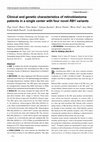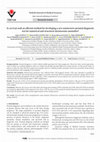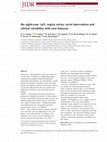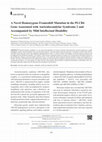Papers by Gülsüm Kayhan
Clinical dysmorphology, Jun 4, 2024
Molecular syndromology, Apr 12, 2024
Molecular syndromology, Feb 23, 2024
JCEM Case Reports, Dec 31, 2023

International Journal of Ophthalmology, Aug 18, 2023
• AIM: To assess the clinical and genetic characteristics of children diagnosed with retinoblasto... more • AIM: To assess the clinical and genetic characteristics of children diagnosed with retinoblastoma (RB) at Gazi University Faculty of Medicine's Department of Pediatric Oncology. • METHODS: All cases diagnosed with RB and received treatment and follow-up in the Ophthalmology and Pediatric Oncology Department, October 2016 to May 2021 were evaluated retrospectively. The RB1 gene was analyzed by next-generation sequencing (NGS) technique in DNAs obtained from peripheral blood samples of the patients. • RESULTS: This study included 53 cases with 67 RBaffected eyes during the study period. The mean age was 24.6 (median: 18.5, range: 3-151)mo. There were 15 (22.3%) Group D eyes and 39 (58.2%) Group E eyes. The RB1 gene was sequenced by the NGS method in 19 patients. Heterozygous RB1:NM_000321.3: c.54_76del (p.Glu19AlafsTer4) variant was detected in a 15-month-old female with bilateral RB. Heterozygous RB1:NM_000321.3: c.1814+3A>T variant was detected in a 5.5-month-old male with bilateral RB. The intronic RB1:NM_000321.3: c.1332+4A>G variant was detected in patient 14, a 13-month-old male with unilateral RB. The RB1:NM_000321.3: c.575_576del (p.Lys192SerfsTer10) variant was found in an 18-month-old female with an allele frequency of 37%. These variants have not been reported in the literature and mutation databases. • CONCLUSION: Four novel variants are described and one of them is found in two different patients. This data is crucial for assessing prognosis. It serves as a guide for estimating the long-term risk of secondary malignancy as well as the short-term risk of developing additional malignancies in the same eye and the other eye.
Gazi medical journal, Apr 1, 2024
Journal of Clinical Research in Pediatric Endocrinology, Sep 1, 2020
What is already known on this topic? The 46,XX ovotesticular disorder of sex development (DSD) is... more What is already known on this topic? The 46,XX ovotesticular disorder of sex development (DSD) is rarely observed in humans. It is known that the excessive expression of SRY-related high mobility group box 9 (SOX9) is the cause of SRY-negative 46,XX ovotesticular DSD in the absence of SRY.
European Journal of Medical Genetics, Jul 1, 2023

American Journal of Medical Genetics, Mar 6, 2022
Mesomelic dysplasias are a genetically and clinically heterogeneous group of diseases with more t... more Mesomelic dysplasias are a genetically and clinically heterogeneous group of diseases with more than 10 types defined. This article presents an 18‐year‐old female patient with normal intelligence and a multisystem phenotype including disproportionate short stature, scoliosis, mesomelic limb shortening, radial bowing, short fourth to fifth metacarpals and metatarsals, fusions in the carpal/tarsal bones, operated pes equinovarus, primary amenorrhea, uterine hypoplasia, vesicoureteral reflux, and chronic kidney disease. Whole‐exome sequencing revealed a de novo heterozygous c.881T&gt;G (p.Met294Arg) variant in HOXA11 (NM_005523.6) gene. The variant was located in the homeodomain of HOXA11 and predicted to alter DNA‐binding ability of the protein. In silico analyses indicated that the variant could promote the alterations in the protein–protein interaction. The possible functional effect of the variant was supposed as dominant‐negative. Hoxa11‐mutant mice have been reported to exhibit homeotic transformations in the thoracic and sacral vertebrae, zeugopodal phenotype in forelimb and hindlimb, and urogenital abnormalities. Although mice models were reported as mesomelic dysplasia and urogenital abnormalities (MDUGA), this phenotype has not yet been reported in humans. This was the first case with MDUGA putatively related to a de novo variant in HOXA11.

Turkish Journal of Medical Sciences, Jun 28, 2021
Background/aim: Prenatal diagnosis is vital to obtain healthy generation for risky pregnancies. T... more Background/aim: Prenatal diagnosis is vital to obtain healthy generation for risky pregnancies. There have been several approaches, some of which are routinely applied in clinics to evaluate the possible prenatal deficiencies and/or diseases. In the present study, we aimed to isolate the fetal cells from endocervical samples and try to identify possible anomalies which were proved by Amniocentesis (AS) and chorionic villus sampling (CVS) methods. Materials and methods: Endoservical specimens were collected from 100 pregnant women. Cells were separated in parallel by fluorescence-activated cell sorting (FACS) and magnetic-activated cell sorting (MACS) using human leukocyte antigen (HLA) G233 and placental alkaline phosphatase (PLAP) antibodies. CMA (comprehensive meta-analysis) were carried out and male fetuses were confirmed with Sex determining region Y (SRY) amplification. Results: The percent of HLA G233 and placental and placental alkaline phosphatase (PLAP) positive cells were 4.55% and 84.59%, respectively. The percent of cells positive for both markers was 14.75%. CMA analyses were not informative. (SRY) was amplified in 67% of the samples. Conclusion: However, the success rate of the both cell sorting and scanning of DNA anomalies by aCGH and/or RT-PCR was limited, preventing the applicability of this proposal in the clinics. Still, the success of the proposed method depends on the development of the novel fetal cell-specific antibodies and the improvements in the sorting systems.

Journal of Intellectual Disability Research, Feb 18, 2019
Background Rearrangement of the 1q21 region of chromosome 1 manifests as multiple phenotypes, inc... more Background Rearrangement of the 1q21 region of chromosome 1 manifests as multiple phenotypes, including microcephaly, intellectual disability, dysmorphic facial features, eye abnormalities, cardiac defects, genitourinary anomalies, autism spectrum disorder, psychiatric conditions and seizures. Herein, we describe eight patients with 1q21 deletion and duplication syndromes, and novel deletions and findings. Methods Chromosomal microarray analysis was performed to identify the existence of copy number variation. Quantitative polymerase chain reaction was applied using specific primers for the control and 1q21 region of chromosome 1. Mutational analysis was performed in case 5 using direct genomic sequencing for exons 1-6 in RBM8A. Results Copy number variation analysis identified seven deletions and one duplication of the 1q21 region in the eight patients. In addition, four variations were de novo, and two deletions are reported here for the first time.

Türkiye Klinikleri Journal of Case Reports, 2022
ABS TRACT Auriculocondylar syndrome is a rare autosomal dominant or recessive disorder characteri... more ABS TRACT Auriculocondylar syndrome is a rare autosomal dominant or recessive disorder characterized by question-mark ears, a small mandibular condyle, and micrognathia. From a molecular perspective, auriculocondylar syndrome arises due to mutations in the PLCB4, GNAI3, and EDN1 genes that play roles in the endothelin signaling pathway. Here, we report a patient with findings of auriculocondylar syndrome and an additional mild intellectual disability. The patient's whole exome sequencing analyses revealed a novel homozygous frameshift mutation in the PLCB4 gene related to auriculocondylar syndrome Type 2. Our molecular studies indicated that this mutation caused a downregulation of PLCB4. This type of PLCB4 mutation has seldom been reported in auriculocondylar syndrome-2 patients and only 2 of them have had neurodevelopmental anomalies, as in our patient. We think that this study supports the possibility of intellectual disability in individuals with a homozygous truncating variant in the PLCB4 gene and contributes to the literature.
European Journal of Medical Genetics, Dec 1, 2019

American Journal of Medical Genetics, Oct 10, 2022
Interstitial lung disease (ILD) is a condition affecting the lung parenchyma by inflammation and ... more Interstitial lung disease (ILD) is a condition affecting the lung parenchyma by inflammation and fibrosis and can be caused by various exposures, connective tissue diseases (CTD), and genetic disorders. In this report, a family with five patients having progressive respiratory failure that begins with coughing in adolescence, followed by dyspnea and recurrent spontaneous pneumothorax, and death in early adulthood is presented. The patients were diagnosed to have ILD through clinical and radiological evaluations. Molecular genetic analyses of the family provided two homozygous rare variants in the WRN and SFXN5 genes, co‐segregating with the phenotype. The network analyses pointed out that the variant in the WRN, rather than that in the SFXN5 gene, could be the main factor in the existence of the ILD phenotype, putatively through the altered DNA repair and telomere maintenance pathways. In silico analyses suggested that the variant could affect the exonuclease activity or the stability of the WRN protein. Moreover, the adolescent‐onset pulmonary phenotype described in the case has not been reported in Werner Syndrome, the only disease known to be associated with biallelic WRN pathogenic variants. Thus, the present phenotype could be either a very atypical presentation of Werner syndrome or a new clinical entity associated with the WRN gene.
58th Annual ESPE Meeting (ESPE 2019), 2019
Turkiye Klinikleri Medical Genetics - Special Topics, 2019

American Journal of Medical Genetics, May 23, 2023
Thauvin‐Robinet‐Faivre syndrome (TROFAS; OMIM #617107) is a rare autosomal recessive overgrowth s... more Thauvin‐Robinet‐Faivre syndrome (TROFAS; OMIM #617107) is a rare autosomal recessive overgrowth syndrome characterized by generalized overgrowth, dysmorphic facial features, and delayed psychomotor development caused by biallelic pathogenic variants in the FGF‐1 intracellular binding protein (FIBP) gene. To date, only four patients from two families have been reported. In this report, we present a 4‐year‐old male patient with generalized overgrowth and delayed developmental milestones consistent with this syndrome. In addition, he has unique features that were not reported in previous patients, including drooling, recurrent pulmonary infections, chronic pulmonary disease, hyperextensible elbow joints, hypoplastic nipples, unilateral cryptorchidism, and frequent spontaneous erections. We identified a homozygous, likely pathogenic variant, c.415_416insCAGTTTG (p.Asp139AlafsTer3), which causes a frameshift in the FIBP. Additionally, we identified a homozygous missense variant in the Toll‐like receptor 5(TLR5) gene and a hemizygous missense variant in the chloride voltage‐gated channel 4 (CLCN4) gene, with uncertain significance in either case. In this article, we set out the new observations and also discuss the frequency of the characteristic findings of the syndrome in the patients so far reported.
İstanbul tıp fakültesi dergisi, Mar 11, 2022










Uploads
Papers by Gülsüm Kayhan